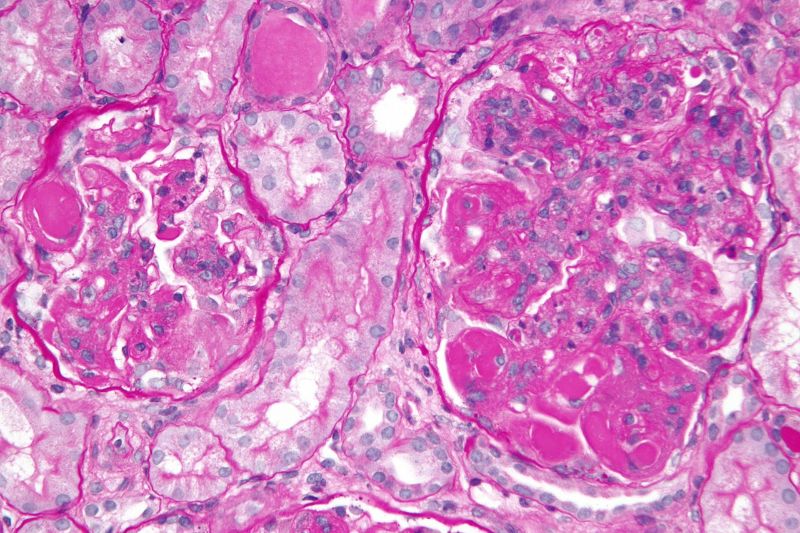What is lupus nephritis?
Lupus nephritis is a kidney disorder that occurs as a complication of systemic lupus erythematosus (SLE), commonly referred to as ‘lupus’. SLE is an autoimmune disease in which the immune system mistakenly attacks healthy tissues and organs in the body.
It can affect most organs including the skin (as rashes), joints, brain, kidneys and heart. When this autoimmune response affects the kidneys, it leads to lupus nephritis.

Typical lupus rash. Usually absent in lupus nephritis
Symptoms
In lupus nephritis, the immune system’s abnormal activity causes inflammation in the kidneys, leading to various kidney problems. These problems can range from mild to severe and may include:
- Proteinuria (protein in the urine). The presence of excess protein in the urine is due to damage to the kidney’s filtering units (glomeruli). Proteinuria can lead to swelling (oedema) in the body, particularly in the legs, ankles, and around the eyes. When the protein loss is high, doctors call it ‘nephrotic syndrome‘
- Haematuria (blood in the urine). This can result from inflammation and damage to blood vessels in the kidneys. This is usually ‘microscopic haematuria’. This means blood that can only be seen by a microscope
- Hypertension (high blood pressure). Lupus nephritis can contribute to elevated blood pressure; which, if left untreated, can further harm the kidneys and other organs
- Chronic kidney disease (CKD). Over time, the inflammation and scarring in the kidneys can lead to a decline in kidney function, leading to chronic kidney disease (CKD). This can progress to Stage 5 CKD and the need for dialysis or a kidney transplant
- Acute kidney injury (AKI). This is less common. It can be severe and lead to the need for short or longterm dialysis. It can also be part of a ‘pulmonary-renal syndrome’. This means AKI that is linked to bleeding in the nose or lungs, which leads to severe nose bleeds or coughing up blood.
The severity and progression of lupus nephritis varies among individuals. Some people may have mild forms that can be managed with medication and regular monitoring. Whilst others may experience more severe kidney damage that requires more aggressive treatment, including strong immunosuppressive drugs – and, in some cases, dialysis or kidney transplantation.
Diagnosis
Lupus nephritis is typically diagnosed through a combination of blood and urine tests, kidney biopsy, and clinical assessment by a specialist kidney doctor (nephrologist).
6 types of lupus nephritis
As well as the classification above (i.e. how it affects you), lupus nephritis can also be classified into several different types based on the findings from a kidney biopsy. They are all forms of glomerulonephritis.
The classification system most commonly used is the International Society of Nephrology/Renal Pathology Society (ISN/RPS) classification. Here are six types of lupus nephritis.
- Class I: Minimal mesangial lupus nephritis. In this type, minimal immune deposits are seen only in the mesangium, a part of the kidney’s glomeruli. Typically, there are no clinical symptoms, and kidney function is normal.
- Class II: Mesangial proliferative lupus nephritis. In Class II, there is an increase in mesangial cells and matrix. It may cause mild proteinuria but often has a favourable prognosis with minimal kidney damage.
- Class III: Focal lupus nephritis (<50% glomeruli affected). Class III lupus nephritis is characterised by active inflammation and immune deposits in some but not all of the glomeruli. It may lead to proteinuria, haematuria, and varying degrees of kidney dysfunction.
- Class IV: Diffuse lupus nephritis (>50% glomeruli affected). This is one of the more severe forms of lupus nephritis, with widespread immune deposits and inflammation throughout the glomeruli. It often causes significant proteinuria, haematuria, and kidney dysfunction (CKD or AKI).

Diffuse lupus nephritis on a kidney biopsy. The pink blobby areas on the bottom left of the biopsy are very abnormal
- Class V: Membranous lupus nephritis. In Class V, there is thickening of the glomerular basement membrane, resulting in a condition known as membranous nephropathy. Patients with this type may have significant proteinuria and, in some cases, nephrotic syndrome.
- Class VI: Advanced sclerotic lupus nephritis. In Class VI, more than 90% of glomeruli are scarred and badly damaged. Patients progress to Stage 5 CKD and will require dialysis or a kidney transplant.
It’s important to note that lupus nephritis can vary in severity and presentation among individuals, and some people may exhibit a combination of these patterns. Accurate classification through kidney biopsy is crucial for determining the appropriate treatment approach.
Treatment
Treatment aims to control the autoimmune response, reduce inflammation, and protect the kidneys from further damage. Medication such as steroids, immunosuppressant drugs, and tablets to control blood pressure are commonly used.
Moderate lupus nephritis
If lupus is more severe, patients may need oral steroids (e.g. prednisolone) and other stronger immunosuppressants (both oral and injections).
These include azathioprine, mycophenolate mofetil, methotrexate, and cyclophosphamide. Such medication dampens your immune system, to stop it from attacking your own tissue.
Newer biological therapies now exist for lupus nephritis. These more specifically target the parts of the immune system that are triggering inflammation and causing damage. The most common biological agents are belimumab and rituximab.
Severe lupus nephritis
If lupus has severely damaged your kidneys, you may also need:
- Plasma exchange
- Dialysis
- Kidney transplantation.
Early diagnosis and prompt treatment are essential for better outcomes and to minimise kidney damage. Patients with lupus nephritis require lifelong care from a nephrologist (preferably one who subspecialises in the condition), with careful monitoring to manage their condition.
Summary
We have described what is lupus nephritis. We hope you have found it helpful.
Other resources
Last Reviewed on 7 May 2024
